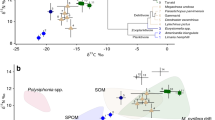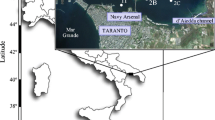Abstract
Cultural eutrophication is one of several environmental stressors that represents a significant ecological threat as the human population continues to grow and encroach on aquatic ecosystems. However, until recently, the environmental impacts of ancient human populations that had low population densities were thought to be largely insignificant relative to those of post-industrial urban society. Based on paleolimnological and archeological data, we have shown that Thule Inuit whalers living in small, nomadic communities were altering High Arctic pond ecology centuries before industrialization. Changes in diatom species assemblage and spectrally inferred aquatic primary production indicate a period of increased production in a pond (E-Knud) on Knud Peninsula, Ellesmere Island, which can be linked to the effects of the Thule from about 810–340 years ago. This site is near the northernmost region of past Thule occupation. Input of nutrients from bowhead whale carcasses, used by the Thule Inuit for sustenance and the construction of winter settlements, as well as other Thule activities (e.g., sealing, human waste, etc.), resulted in an increase in δ15N, which coincided with ecologically significant diatom abundance changes, including an increase in Amphora ovalis. Diatom and nutrient changes also coincided with increased primary aquatic production, as measured by spectrally inferred chlorophyll a concentration. In addition, we recorded relative increases in diatom taxa such as Craticula halophila and Achnanthidum minutissimum in the more recent sediments, which we attribute to recent climate warming, manifested by lower water levels and associated evapo-concentration. Specific conductivities recorded during three sampling years (2004, 2006, 2009) show a trend of increasing conductivity in pond E-Knud in response to declining water levels. Together these changes in diatom species abundance suggest that multiple environmental stressors, operating several centuries apart, have led to marked limnological changes in E-Knud pond.



Similar content being viewed by others
References
Antoniades, D., M. S. V. Douglas & J. P. Smol, 2005. Quantitative estimates of recent environmental changes in the Canadian High Arctic inferred from diatoms in lake and pond sediments. Journal of Paleolimnology 33: 349–360.
Antoniades, D., P. B. Hamilton, M. S. V. Douglas & J. P. Smol, 2008. Diatoms of North America: the freshwater floras of Prince Patrick, Ellef Ringnes and northern Ellesmere Islands from the Canadian Arctic Archipelago. Iconographia Diatomologica 17: 1–703.
Bennion, H., 1994. A diatom-phosphorus transfer function for shallow eutrophic ponds in Southeast England. Hydrobiologia 275(276): 391–410.
Blais, J. M., L. E. Kimpe, D. McMahon, B. E. Keatley, M. L. Mallory, M. S. V. Douglas & J. P. Smol, 2005. Arctic seabirds transport marine-derived contaminants. Science 309: 445.
Blais, J. M., R. W. Macdonald, D. Mackay, E. Webster, C. Harvey & J. P. Smol, 2007. Biologically mediated transport of contaminants to aquatic ecosystems. Environmental Science & Technology 41: 1075–1084.
Cumming, B. F., S. E. Wilson, R. I. Hall & J. P. Smol, 1995. Diatoms from British Columbia (Canada) lakes and their relationship to salinity, nutrients and other limnological variables. In Lange-Bertalot, H. (ed.), Bibliotheca Diatomologica, Band 31. Gebruder Borntraeger, Berlin.
deFreitas, T. A. & U. Mayer, 2007. Geology, Sawyer Bay, Ellesmere Island, Nunavut. Geological Survey of Canada, Map 2103A, scale 1:125,000.
Douglas, M. S. V. & J. P. Smol, 2000. Eutrophication and recovery in the High Arctic: Meretta Lake (Cornwallis Island, Nunavut, Canada) revisited. Hydrobiologia 431: 193–204.
Douglas, M. S. V., J. P. Smol, J. M. Savelle & J. M. Blais, 2004a. Prehistoric Inuit whalers affected Arctic freshwater ecosystems. Proceedings in the National Academy of Sciences of the United States of America 101: 1613–1617.
Douglas, M. S. V., P. B. Hamilton, R. Pienitz & J. P. Smol, 2004b. Algal indicators of environmental change in arctic and antarctic lakes and ponds, Vol. 8. In Pienitz, R., M. S. V. Douglas & J. P. Smol (eds), Long-term environmental change in Arctic and Antarctic lakes. developments in paleoenvironmental research. Springer, Dordrecht, The Netherlands: 117–159.
Dyke, A. S., J. Hooper & J. M. Savelle, 1996. A history of sea ice in the Canadian Arctic Archipelago based on postglacial remains of the bowhead whale (Balaena mysticetus). Arctic 49: 235–255.
Ekdahl, E. J., J. L. Teranes, C. A. Wittkop, E. F. Stoermer, E. D. Reavie & J. P. Smol, 2007. Diatom assemblage response to Iroquoian and Euro-Canadian eutrophication of Crawford Lake, Ontario, Canada. Journal of Paleolimnology 37: 233–246.
Finney, B. P., I. Gregory-Eaves, J. Sweetman, M. S. V. Douglas & J. P. Smol, 2000. Impacts of climatic change and fishing on Pacific salmon abundance over the past 300 years. Science 290: 795–799.
Finney, B. P., I. Gregory-Eaves, M. S. V. Douglas & J. P. Smol, 2002. Fisheries productivity in the northeast Pacific over the past 2,200 years. Nature 416: 729–733.
Glew, J., 1988. A portable extruding device for close interval sectioning of unconsolidated core samples. Journal of Paleolimnology 1: 235–239.
Glew, J., 1989. A new trigger mechanism for sediment samplers. Journal of Paleolimnology 2: 241–243.
Glew, J., 2001. Sediment core collection and extrusion. In Last, W. M. & J. P. Smol (eds), Tracking Environmental Change Using Lake Sediments. Volume 1: Basin Analysis, Coring and Chronological Techniques. Kluwer Academic Publishers, Dordrecht, The Netherlands: 73–107.
Gregory-Eaves, I., J. P. Smol, M. S. V. Douglas & B. P. Finney, 2003. Diatoms and sockeye salmon (Oncorhynchus nerka) population dynamics: Reconstructions of salmon-derived nutrients over the past 2,200 years in two lakes from Kodiak Island, Alaska. Journal of Paleolimnology 30: 35–53.
Hadley, K. R., 2007. Assessing Thule Inuit impacts on High Arctic lakes and ponds: a paleolimnological approach. (MSc thesis, Department of Biology, Queen’s University, Kingston). http://qspace.library.queensu.ca/handle/1974/961.
Hadley, K. R., M. S. V. Douglas, R. H. McGhee & J. P. Smol, 2010. Ecological influences of Thule Inuit whalers on high Arctic pond ecosystems: a comparative paleolimnological study from Bathurst Island (Nunavut, Canada). Journal of Paleolimnology. doi:10.1007/s10933-009-9388-6.
Keatley, B. E., M. S. V. Douglas & J. P. Smol, 2006. Early-20th century environmental changes inferred using subfossil diatoms from a small pond on Melville Island. N.W.T., Canadian high Arctic. Hydrobiologia 553: 15–26.
Keatley, B. E., M. S. V. Douglas & J. P. Smol, 2007. Limnological characteristics of a high Arctic oasis and comparisons across northern Ellesmere Island. Arctic 60: 294–308.
Krammer, K. & H. Lange-Bertalot, 1986–1991. Bacillariophyceae. In Ettl, H., J. Gerloff, H. Heynig, & D. Mollenhauer (eds), Subwasserfloa von Mitteleuropa, Band 2(2–4). Gustav Fischer Verlag, Stuttgart/Jena.
Krümmel, E. M., M. Scheer, I. Gregory-Eaves, R. W. MacDonald, L. Kimpe, J. P. Smol, B. Finney & J. M. Blais, 2009. Historical analysis of salmon-derived polychlorinated biphenyls (PCBs) in lake sediments. Science of the Total Environment 407: 1977–1989.
Maxwell, M. S., 1985. Prehistory of the Eastern Arctic. Academic Press, Orlando.
McCartney, A. P., 1977. Thule Eskimo prehistory along the Northwestern Hudson Bay. National Museum of Man. Mercury Series, Archaeological Survey of Canada Paper No. 70, Ottawa, ON, Canada.
McCullough, K. M., 1989. The Ruin Islanders: Early Thule Culture Pioneers in the Eastern High Arctic. Archaeological Survey of Canada Mercury Series Paper No. 141. Canadian Museum of Civilization, Ottawa.
McGhee, R., 2009. The population size and temporal duration of Thule culture in Arctic Canada. In B Gronnow (ed.), On the track of the Thule culture from Alaska to East Greenland. National Museum of Denmark, Copenhagen: 75–91.
McGowan, S., D. B. Ryves & N. J. Anderson, 2003. Holocene records of effective precipitation in West Greenland. The Holocene 13: 239–249.
Michelutti, N., M. S. V. Douglas, D. C. G. Muir, X. Wang & J. P. Smol, 2002. Limnological characteristics of 38 lakes and ponds on Axel Heiberg Island, High Arctic Canada. International Review of Hydrobiology 87: 385–399.
Michelutti, N., A. P. Wolfe, R. D. Vinebrooke & B. Rivard, 2005. Recent primary production increases in arctic lakes. Geophysical Research Letters 32: L19715.
Michelutti, N., B. E. Keatley, S. Brimble, J. M. Blais, H. Lui, M. S. V. Douglas, M. L. Mallory, R. W. MacDonald & J. P. Smol, 2009. Seabird-driven shifts in Arctic pond ecosystems. Proceedings of the Royal Society B 276: 591–596.
Michelutti, N., J. M. Blais, B. F. Cumming, A. M. Paterson, K. Rühland, A. P. Wolfe & J. P. Smol, 2010. Do spectrally inferred determinations of chlorophyll a reflect trends in lake trophic status? Journal of Paleolimnology 43: 205–217.
Moore, J. J., K. A. Hughen, G. H. Miller & J. T. Overpeck, 2001. Little Ice Age recorded in summer temperature reconstruction from varved sediments of Donard Lake, Baffin Island, Canada. Journal of Paleolimnology 25: 503–517.
Parr, J. F., K. H. Taffs & C. M. Lane, 2004. A microwave digestion technique for the extraction of fossil diatoms from coastal lake and swamp sediments. Journal of Paleolimnology 31: 383–390.
Pienitz, R., J. P. Smol, W. M. Last, P. R. Leavitt & B. F. Cumming, 2000. Multi-proxy Holocene palaeoclimatic record from a saline lake in the Canadian Subarctic. The Holocene 10: 673–686.
Schledermann, P., 1976. The effect of climatic/ecological changes on the style of Thule culture winter dwellings. Arctic and Alpine Research 8: 37–47.
Schledermann, P. & K. M. McCullough, 2003. Late Thule Culture Developments on the Central East Coast of Ellesmere Island. Danish Polar Center, Copenhagen: 20–30.
Smol, J. P. & M. S. V. Douglas, 2007a. Crossing the final ecological threshold in high Arctic ponds. Proceedings in the National Academy of Sciences of the United States 104: 12395–12397.
Smol, J. P. & M. S. V. Douglas, 2007b. From controversy to consensus: making the case for recent climatic change in the Arctic using lake sediments. Frontiers in Ecology and the Environment 5: 466–474.
Sverdrup, O., 1904. New Land: Four years in the Arctic regions. Longman, Green, and Co, London.
Whitridge, P., 2002. Social and ritual determinants of whale bone transport at a classic Thule winter site in the Canadian Arctic. International Journal of Osteoarchaeology 12: 65–75.
Wolfe, A. P., G. H. Miller, C. A. Olsen, S. L. Forman, P. T. Doran & S. U. Holmgren, 2004. Geochronology of high latitude lake sediments. In Pienitz, R., M. S. V. Douglas & J. P. Smol (eds), Long-term Environmental Change in Arctic and Antarctic Lakes. Developments in Paleoenvironmental Research, Vol. 8. Springer, Dordrecht, The Netherlands.
Wolfe, A. P., R. D. Vinebrooke, N. Michelutti, B. Rivard & B. Das, 2006. Experimental calibration of lake-sediment spectral reflectance to chlorophyll a concentrations: methodology and paleolimnological validation. Journal of Paleolimnology 36: 91–100.
Acknowledgments
The authors wish to thank Alyson Paul, Marco Viscomi, Bronwyn Keatley, and Chris Grooms for assistance in the field. This study has been made possible by the NSERC and PCSP research grants of John P. Smol and Marianne S.V. Douglas, as well as the NSTP grant of Kris Hadley. We also acknowledge Linda Kimpe and the G.G. Hatch Stable Isotope Laboratory at the University of Ottawa for isotope analysis. We would also like thank Dr. Karen McCullough for assistance with site selection. X. Wang (CCIW) and NLET are gratefully acknowledged for assistance with the water chemistry. Dr. I Rod Smith and two anonymous journal reviewers provided many helpful comments on a previous version of this article.
Author information
Authors and Affiliations
Corresponding author
Additional information
Handling editor: M. Power
Rights and permissions
About this article
Cite this article
Hadley, K.R., Douglas, M.S.V., Blais, J.M. et al. Nutrient enrichment in the High Arctic associated with Thule Inuit whalers: a paleolimnological investigation from Ellesmere Island (Nunavut, Canada). Hydrobiologia 649, 129–138 (2010). https://doi.org/10.1007/s10750-010-0235-6
Received:
Revised:
Accepted:
Published:
Issue Date:
DOI: https://doi.org/10.1007/s10750-010-0235-6




